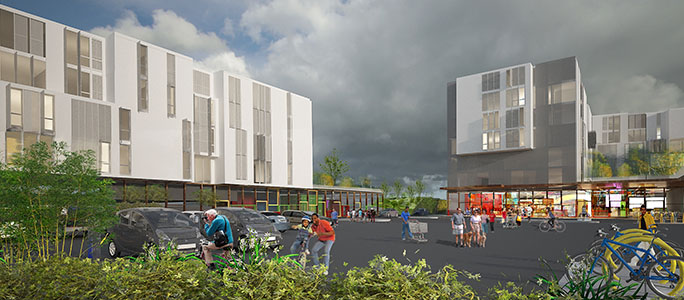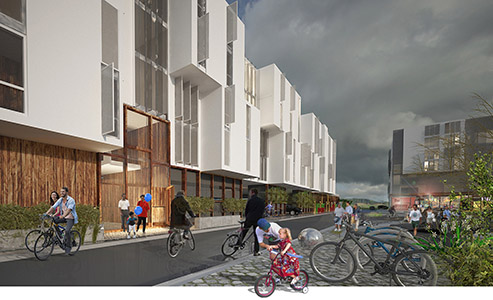Oakland-based architectural firm 3r studio received top honors last month at a Bay Area news conference announcing the winners of the fourth annual Architecture at Zero design competition.

The land chosen for this yearís Architecture at Zero competition is currently occupied by a shopping plaza and a senior housing complex. Competition guidelines dictated that the senior housing was to be incorporated into the redesign, along with a grocery store, market rate and affordable housing, and a childcare center or wellness clinic. Winners 3r studio reimagined the site as a bustling neighborhood unto itself with pocket-parks and other open spaces for residents to enjoy. Image courtesy of 3r studio
By Bill Picture
Published: January, 2015
Oakland-based architectural firm 3r studio received top honors last month at a Bay Area news conference announcing the winners of the fourth annual Architecture at Zero design competition.
Every year, as part of the competition, established architects and architects-to-be are invited to take a real-life piece of real estate and dream up a zero net energy building—that is, a building whose energy needs are covered by renewable energy created onsite.
Architecture at Zero is sponsored by Pacific Gas & Electric (PG&E) and the American Institute of Architects Foundation (AIAF), who choose an area and then work with a local community partner to identify a site and set parameters that will test the skills and imaginations of designers.
This year, PG&E and AIAF partnered with East Bay Asian Local Development Corporation (EBALDC), a non-profit community development organization, to select land in west Oakland that is owned by EBALDC and already being eyed for potential redevelopment.
A real site with real challenges
“The site they chose this year has a lot of constraints within it,” said competition advisor Margie O’Driscoll. “It’s midway between two BART stations and sits near a freeway junction. It’s also in a neighborhood that, for better or worse, is beginning to experience gentrification.”
The site, Jack London Gateway at 900 Market Street in Oakland, is actually two adjacent parcels of land. Currently home to a shopping plaza with no anchor store, a stand-alone fast-food chain and a newly built senior housing development, you’d be hard-pressed to find anyone who will argue the site is living up to its full potential.
Designers were instructed to envision each parcel as a bustling mixed-use site, with people living in homes above ground-floor commercial space. The first parcel was to house a childcare center or wellness clinic on the ground floor, with multiple floors of affordable family housing upstairs. The second parcel was to feature market-rate housing atop a grocery store. And just to make sure designers didn’t get bored, organizers specified that the senior housing had to be incorporated into the proposed design. Designers also had to contend with existing height restrictions in the area.
“These are all things that the neighborhood needs badly,” O’Driscoll said. “For instance, there’s no grocery store in the area. That’s actually what sparked interest in the competition. People who live here now have to go to another neighborhood to do their shopping. And higher-density housing would help the neighborhood attract one of the big supermarket chains. In this case, the market would have customers living right above it.”
No wrong answers
3r studio, whose design was named “Embracing Limits,” imagined very linear, loft-like dwellings that allow in lots of natural light, and surrounding pockets of green space for residents to enjoy. It tied for an Honor Award in the Professional category with another team made up of designers from Canada and Spain, whose “Symbiosis” design, set inside an estate-like setting with green expanses and pools, was inarguably sleeker but not quite as homey.
Designs earning Merit Awards in the Student category ranged from a serpentine complex winding its way through green space to a modern take on the traditional apartment block. “It’s always interesting to see what the students come up with,” O’Driscoll said. “With less real-world experience to hold them back, they’re much more about pushing the boundaries of possibility. And it’s important that we encourage students to think outside the box, because they’ll have to wrestle much more vigorously with climate change than people of, say, my generation.”
Entries are reviewed by a panel of judges consisting of high-profile architects and engineers, and a senior design editor from the magazine Architect. While aesthetics are important and it never hurts to design a green building that’s also pretty, the proof in the pudding is the building’s energy performance.
“The designers have to fill out a complete energy assessment, and there’s a very strenuous review of the details by the judges to make sure a building will perform well,” O’Driscoll said.
That makes absolute sense considering the intent of the competition is to inspire a brainstorm of innovative ways to meet energy challenges that can be incorporated into building designs to help the state achieve goals set by the California Public Utilities Commission (CPUC). In a 2008 report, the CPUC vowed that by 2020 all new residential buildings constructed in California would be zero net energy. 2030 was set as the goal for new commercial buildings in the state.
“The zero net energy design competition is an important forum in helping shape California’s energy future,” said Vincent Davis, PG&E’s senior director of energy efficiency programs, in a written statement. “The innovative plans featured in this year’s competition continue to raise the bar in energy efficient design and bring fresh perspective on what is possible today.”
The next step
For their hard work, winners received a mix of cash and prizes, and their designs will go on to inspire the future of Jack London Gateway. But it’s up to the EBALDC, which owns the property, to decide when and how to move forward.
While both winning designs are ready to go up as-is, what ends up being built on the two parcels of land may incorporate key elements from “Embracing Limits” and “Symbiosis” but resemble neither.
That’s what has happened in previous years, which gave designers the challenge of designing net zero energy buildings in San Francisco’s Tenderloin neighborhood, in Emeryville, and on the UC Merced campus. Driscoll said that after the 2012 competition, UC Merced created a master plan for the campus that included a building with “many, if not all” of the features of the winning net zero energy design.
“At the end of the day, it’s about what the community wants, and wants it to look like,” O’Driscoll said. “The goal of this competition is to present them with some great solutions, and to get the community excited about the idea of a net zero energy building.”
As for whether we can expect to see the ideas spawned by the competition become the norm for architects and developers in our lifetime, O’Driscoll says we’ll have to wait and see. “We’re making great strides, but I think we’ve got a long way to go.”
For information on the Architecture at Zero competition and this year’s winners, visit www.architectureatzero.com.

Oakland-based 3r studio received top honors at the 4th Annual Architecture at Zero design competition for its mixed-used development. Every year, the competitionís organizers, Pacific Gas & Electric and the American Institute of Architects Foundation, choose a parcel of land and invite designers to imagine a building that will produce enough clean energy to cover its annual needs. Image courtesy of 3r studio

